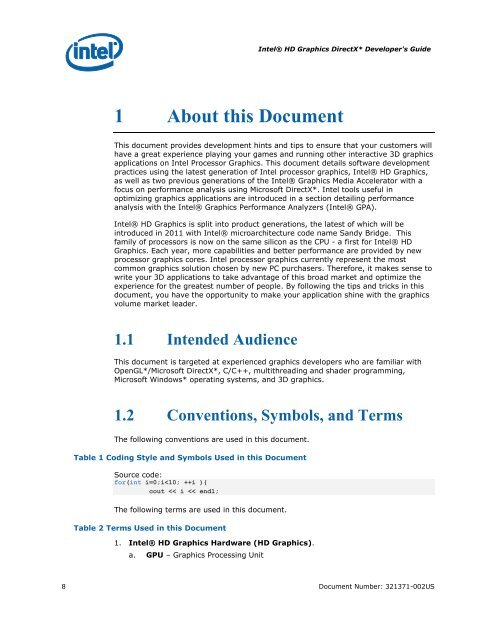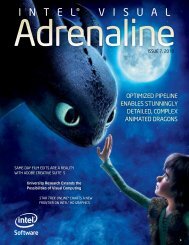Intel HD Graphics DirectX Developer's Guide (Sandy Bridge)
Intel HD Graphics DirectX Developer's Guide (Sandy Bridge)
Intel HD Graphics DirectX Developer's Guide (Sandy Bridge)
You also want an ePaper? Increase the reach of your titles
YUMPU automatically turns print PDFs into web optimized ePapers that Google loves.
1 About this Document<br />
<strong>Intel</strong>® <strong>HD</strong> <strong>Graphics</strong> <strong>DirectX</strong>* <strong>Developer's</strong> <strong>Guide</strong><br />
This document provides development hints and tips to ensure that your customers will<br />
have a great experience playing your games and running other interactive 3D graphics<br />
applications on <strong>Intel</strong> Processor <strong>Graphics</strong>. This document details software development<br />
practices using the latest generation of <strong>Intel</strong> processor graphics, <strong>Intel</strong>® <strong>HD</strong> <strong>Graphics</strong>,<br />
as well as two previous generations of the <strong>Intel</strong>® <strong>Graphics</strong> Media Accelerator with a<br />
focus on performance analysis using Microsoft <strong>DirectX</strong>*. <strong>Intel</strong> tools useful in<br />
optimizing graphics applications are introduced in a section detailing performance<br />
analysis with the <strong>Intel</strong>® <strong>Graphics</strong> Performance Analyzers (<strong>Intel</strong>® GPA).<br />
<strong>Intel</strong>® <strong>HD</strong> <strong>Graphics</strong> is split into product generations, the latest of which will be<br />
introduced in 2011 with <strong>Intel</strong>® microarchitecture code name <strong>Sandy</strong> <strong>Bridge</strong>. This<br />
family of processors is now on the same silicon as the CPU - a first for <strong>Intel</strong>® <strong>HD</strong><br />
<strong>Graphics</strong>. Each year, more capabilities and better performance are provided by new<br />
processor graphics cores. <strong>Intel</strong> processor graphics currently represent the most<br />
common graphics solution chosen by new PC purchasers. Therefore, it makes sense to<br />
write your 3D applications to take advantage of this broad market and optimize the<br />
experience for the greatest number of people. By following the tips and tricks in this<br />
document, you have the opportunity to make your application shine with the graphics<br />
volume market leader.<br />
1.1 Intended Audience<br />
This document is targeted at experienced graphics developers who are familiar with<br />
OpenGL*/Microsoft <strong>DirectX</strong>*, C/C++, multithreading and shader programming,<br />
Microsoft Windows* operating systems, and 3D graphics.<br />
1.2 Conventions, Symbols, and Terms<br />
The following conventions are used in this document.<br />
Table 1 Coding Style and Symbols Used in this Document<br />
Source code:<br />
for(int i=0;i













